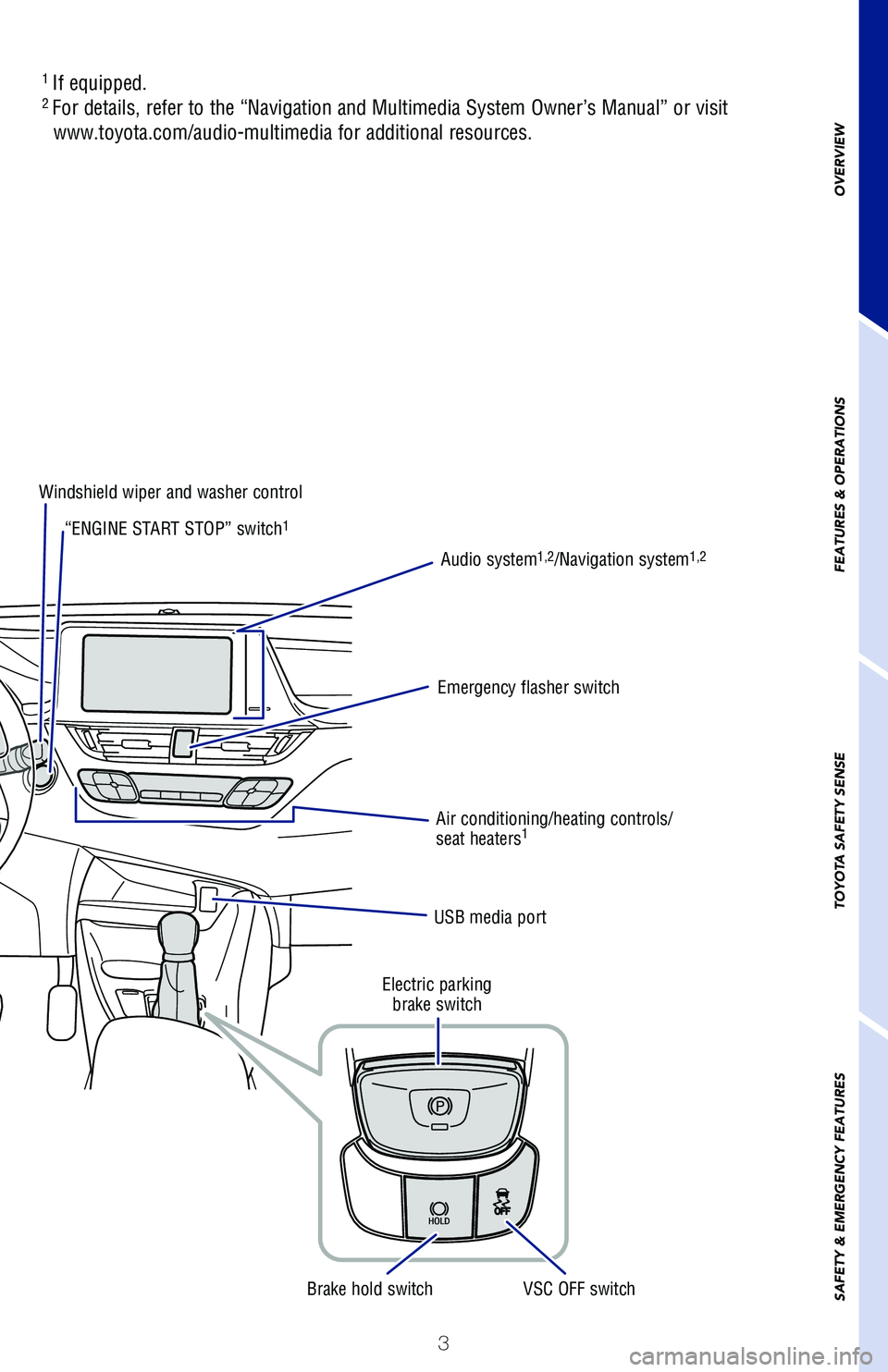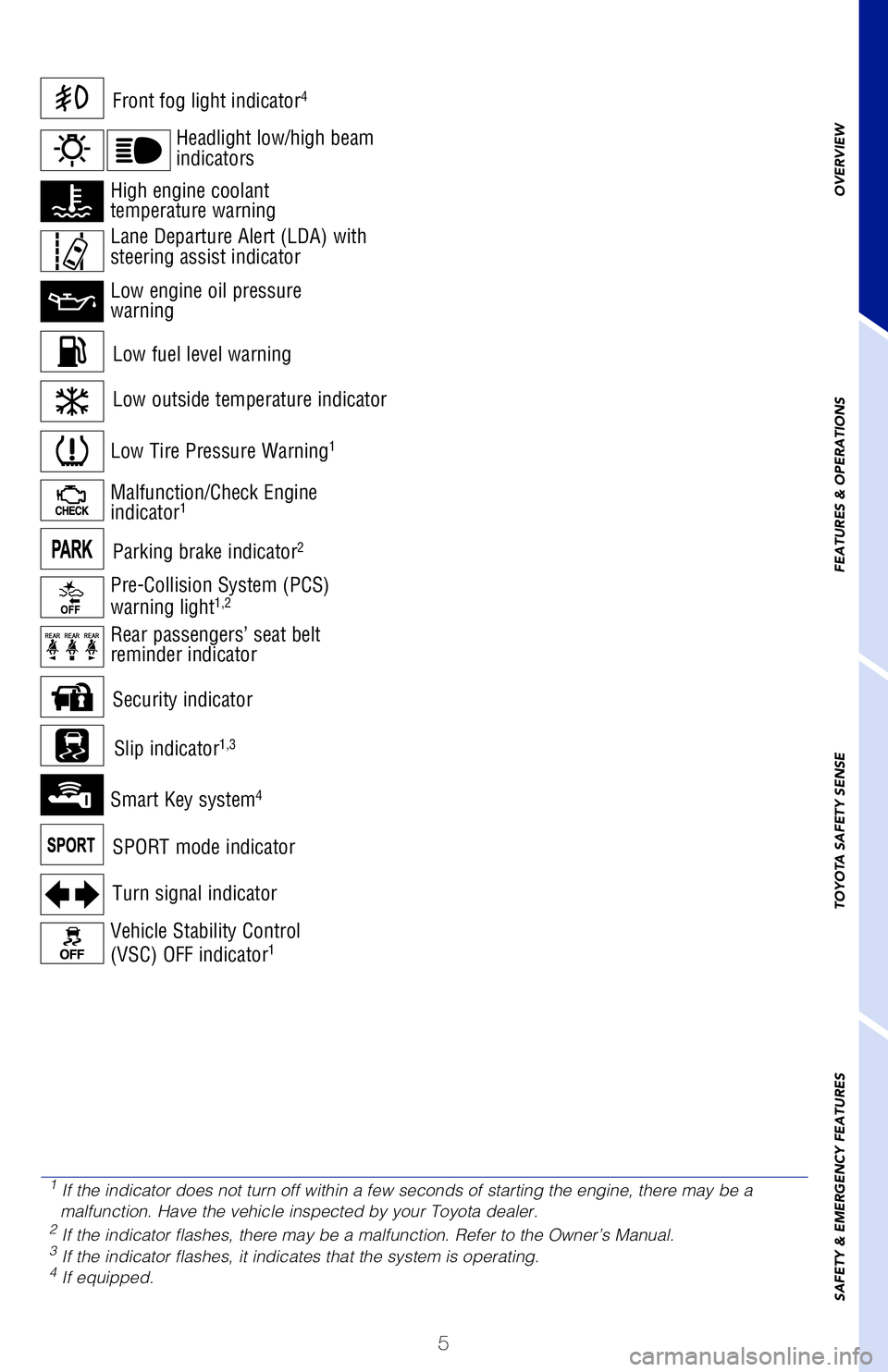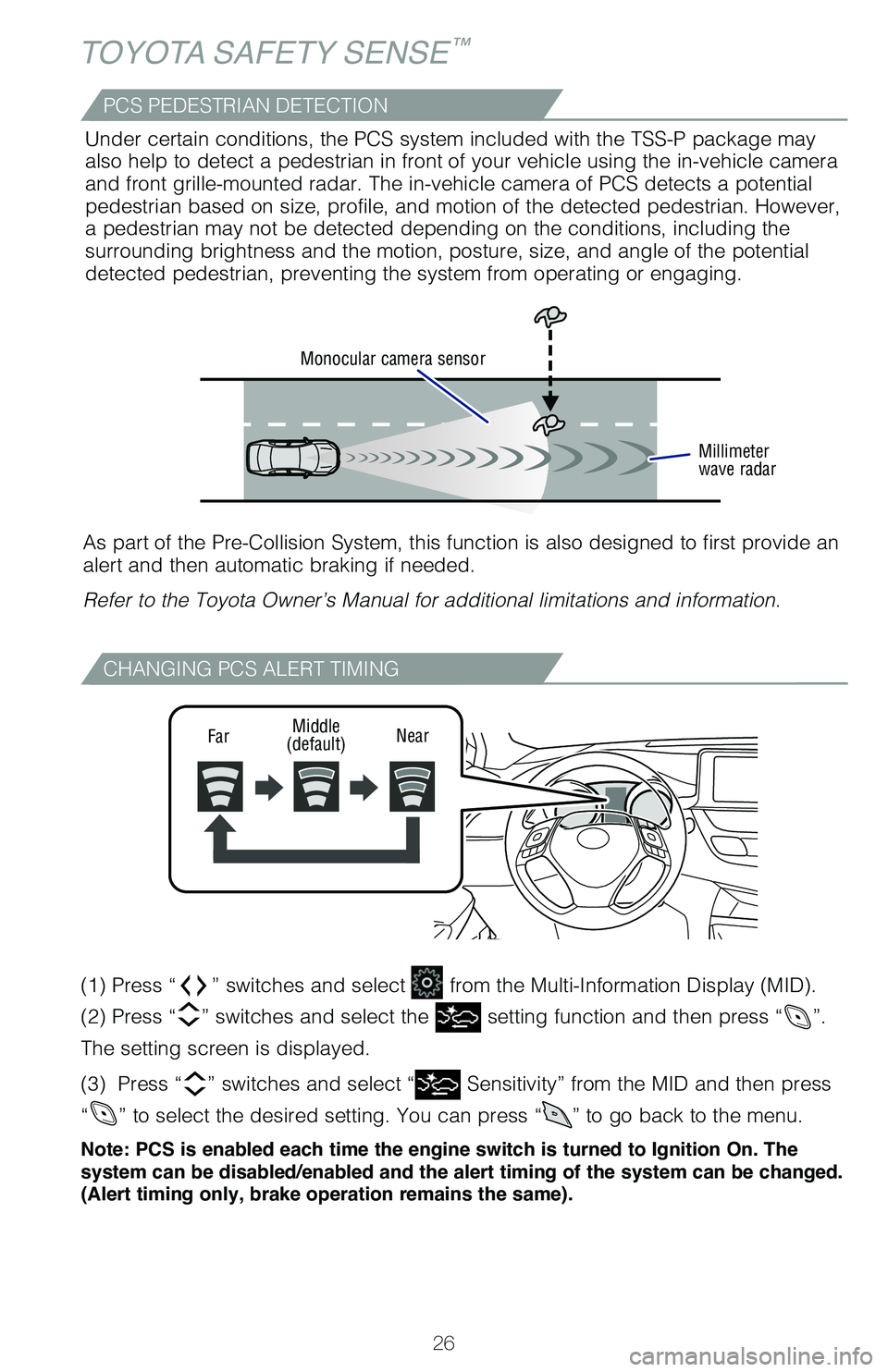brake TOYOTA C-HR 2020 Owners Manual (in English)
[x] Cancel search | Manufacturer: TOYOTA, Model Year: 2020, Model line: C-HR, Model: TOYOTA C-HR 2020Pages: 48, PDF Size: 3.81 MB
Page 3 of 48

1
OVERVIEW
FEATURES & OPERATIONS
TOYOTA SAFETY SENSE
SAFETY & EMERGENCY FEATURES
1 Visit your Toyota dealer for information on customizing this feature.2 Programmable by customer. Refer to the Owner’s Manual for instructio\
ns and more information.
INDEX
Engine maintenance 9
Fuel tank door release & cap 8
Hood release 8
Indicator symbols 4-5
Instrument cluster 4
Instrument panel 2-3
Instrument panel light control 9
Keyless entry
1,2 6
Smart Key system1,2 7
OVERVIEW
FEATURES & OPERATIONS
Air conditioning/heating 18
Audio 20
Auxiliary storage 17
Blind Spot Monitor (BSM) and
Rear Cross Traffic Alert (RCTA) 22
Clock 19
Continuously variable transmission 10
Cup holders 17
Door locks 16
Driving mode select 10
Electric parking brake 11
Lights
1 & turn signals 12
Multi-Information Display (MID)1 15
Power outlet-12V DC 20
Rear view monitor system 23
Seat adjustments-Front 14
Seat heaters 19
Seats-Folding rear 14
Seats-Head restraints 14
Steering lock release 16
Steering wheel switches &
telephone controls (Bluetooth
®) 21
Tilt & telescopic steering wheel 16
Vehicle Stability Control (VSC)/
TRAC OFF switch 23
USB media port 21
Windows-Power 17
Windshield wipers & washers 13
SAFETY & EMERGENCY FEATURES
TOYOTA SAFETY SENSE™ P (TSS-P)
Automatic High Beams (AHB) 34
Full-Speed Range Dynamic Radar
Cruise Control (DRCC) 31-33
Lane Departure Alert with
Steering Assist (LDA w/SA) 27-30
Pre-Collision System with Pedestrian
Detection (PCS w/PD) 25-27
Quick overview-
Toyota Safety Sense
™ P (TSS-P) 24
Sensors 24
BLUETOOTH® DEVICE
PAIRING SECTION 42-44
Floor mat installation
40
Rear door chile safety locks 35
Safety Connect 37
Seat belts 35
Seat belts-Shoulder belt anchor 35
Spare tire & tools 38
Star Safety System
TM 39-40
Tire Pressure Monitoring
(warning) System (TPMS) 36
Page 5 of 48

3
OVERVIEW
FEATURES & OPERATIONS
TOYOTA SAFETY SENSE
SAFETY & EMERGENCY FEATURES
Air conditioning/heating controls/
seat heaters1
USB media port
Windshield wiper and washer control
Emergency flasher switchAudio system
1,2/Navigation system1,2
Electric parking
brake switch
VSC OFF switch
Brake hold switch
“ENGINE START STOP” switch
1
1
If equipped.2 For details, refer to the “Navigation and Multimedia System Owner’s M\
anual” or visit
www.toyota.com/audio-multimedia for additional resources.
Page 6 of 48

4
OVERVIEWInstrument cluster
Indicator symbols
For details, refer to “Indicators and warning lights,” Section 2, 202\
0 Owner’s
Manual.
Automatic High Beam (AHB)
indicator
Electric power steering system
warning (red/yellow)1
BSM outside rear view mirror
indicators1,4
Charging system warning
Brake Override System/
Drive-Start Control ECO MODE indicator
Eco Driving Indicator
Arrow direction indicates fuel tank
door position
Anti-lock Brake System (ABS)
warning1
Blind Spot Monitor (BSM) OFF
indicator1,4
Brake system warning1
Brake system warning (yellow)1
Brake hold operated indicator1,2
Brake hold standby indicator1
“AIRBAG ON/OFF” indicator1
AIRBAG SRS warning1
Service indicators and reminders
“RCTA OFF” indicator2,4
Driver’s and front passenger’s seat belt
reminder (alarm will sound when the
engine switch is IGNITION ON mode)
Constant speed cruise control
indicator/Constant speed
cruise control SET indicator
Full-Speed Dynamic Radar
Cruise Control (DRCC)
indicator/DRCC SET indicator
Tachometer Outside temperature
Fuel gauge
Shift position and
shift range
Engine coolant
temperature gauge
Odometer/
trip meterMulti-Information Display
Speedometer
Page 7 of 48

5
OVERVIEW
FEATURES & OPERATIONS
TOYOTA SAFETY SENSE
SAFETY & EMERGENCY FEATURES
Low fuel level warning
Front fog light indicator4
Turn signal indicator
Low Tire Pressure Warning1
Vehicle Stability Control
(VSC) OFF indicator1
Malfunction/Check Engine
indicator1
Low engine oil pressure
warning
High engine coolant
temperature warning
Smart Key system4
ECO MODE indicator
SPORT mode indicator
Parking brake indicator2
Headlight low/high beam
indicators
Pre-Collision System (PCS)
warning light1,2
Rear passengers’ seat belt
reminder indicator Lane Departure Alert (LDA) with
steering assist indicator
Slip indicator1,3
Security indicator
Low outside temperature indicator
1
If the indicator does not turn off within a few seconds of starting the en\
gine, there may be a
malfunction. Have the vehicle inspected by your Toyota dealer.
2 If the indicator flashes, there may be a malfunction. Refer to the Owne\
r’s Manual.3 If the indicator flashes, it indicates that the system is operating.4 If equipped.
Page 9 of 48

7
OVERVIEW
FEATURES & OPERATIONS
TOYOTA SAFETY SENSE
SAFETY & EMERGENCY FEATURES
Smart Key system (if equipped)
START FUNCTION
POWER (WITHOUT STARTING ENGINE)
Off - All systems OFF. Emergency flashers can be used.
Accessory – Some electrical components can be used.
On - All electrical components can be used.
NOTE: The Smart Key must be carried to enable the start function. With the
gear shift lever in Park and the brake pedal depressed, push the “ENGINE
START STOP” button.
Without depressing the brake pedal, pressing the engine switch will change the
operation mode in succession from:
IGNITION ON
ACCESSORY
Page 12 of 48

10
Continuously variable transmission
* The engine switch must be in the “ON” position (without Smart Ke\
y) / “IGNITION ON” mode (with Smart Key) and the brake pedal depressed to shift from Par\
k.
Shift the shift lever to “M” position from “D” position.
+: Upshifting (push and release)
-: Downshifting (pull and release)
Downshifting increases power going uphill, or provides engine braking downhill. For
best fuel economy during normal driving conditions, always drive with the sh\
ift lever
in the “D” position.
Refer to the Owner’s Manual for more details.
FEATURES & OPERATIONS
7-SPEED SPORT SEQUENTIAL SHIFTMATIC MODE (M POSITION)
M
P
R
N
D
Park*
Reverse
Neutral
Drive
“M” position
+ (M position)
- (M position)
Use the the steering wheel meter control switches to operate the MID. See
above.
Driving mode select
“NORMAL” - Suitable for city driving.
“SPORT” - Suitable for roads with many curves needing improved driving response\
.
“ECO” - Suitable for improved fuel economy and energy saving controlled air/
heating.
(1) Press steering wheel switches “
” to find and select in the MID.
(2) Press steering wheel switches “
” switches and select “Drive Mode” in the MID.
(3) Select a driving mode:
The “SPORT” and “ECO” indicators display in the Multi-Informati\
on Display (MID).
Note: Operation of the LDA system and setting adjustments continues in the same
condition regardless of Ignition cycle until changed by the driver or the system is reset.
Page 13 of 48

11
OVERVIEW
FEATURES & OPERATIONS
TOYOTA SAFETY SENSE
SAFETY & EMERGENCY FEATURES
PARKING BRAKE
Electric parking brake
Automatic modeManual mode
Automatic
Manual To turn automatic mode ON, while vehicle is stopped, pull and hold switch \
until
“EPB Shift Interlock Function Activated” displays in Multi-Information Di\
splay (MID).
While depressing brake, shifting into P position will automatically set the b\
rake
and turn the parking brake indicator and parking brake light on. To release\
brake,
depress brake and shift out of P. The indicator light and the light on the swit\
ch turn
off.
To turn automatic mode OFF, push and hold parking brake switch until “E\
PB Shift
Interlock Function Deactivated” displays on the MID.
While vehicle is stopped and brake pedal is depressed, pull to set parking br\
ake
and turn the parking brake indicator and parking brake light on. To release\
, press
the brake pedal and push switch. The indicator light turns off.
The brake hold system keeps the brake applied when the shift lever is in an\
y
position other than P or R with the system on and the brake pedal has been
depressed to stop the vehicle (yellow indicator light.) The system releases the\
brake when the accelerator pedal is depressed with the shift lever in any pos\
ition
other than P or N to allow smooth start off (green indicator light.)
Refer to the Owner’s Manual for limitations and more details.
BRAKE HOLD
Page 27 of 48

25
OVERVIEW
FEATURES & OPERATIONS
TOYOTA SAFETY SENSE
SAFETY & EMERGENCY FEATURES
The Pre-Collision System with Pedestrian Detection uses a radar sensor and \
camera
sensor to help detect a vehicle or pedestrian in front of your vehicle.
As there is a limit to the degree of recognition accuracy and control perf\
ormance
that this system can provide, do not overly rely on this system. This system\
will not
prevent collisions or lessen collision damage or injury in every situation. Do \
not use
PCS w/PD instead of normal braking operations under any circumstances. Do n\
ot
attempt to test the operation of the pre-collision system yourself, as the syst\
em may
not operate or engage, possibly leading to an accident. In some situations,\
such as
when driving in inclement weather such as heavy rain, fog, snow or a sandsto\
rm or
while driving on a curve and for a few seconds after driving on a curve, a ve\
hicle or
pedestrian may not be detected by the radar and camera sensors, preventing the
system from operating or engaging properly.
Refer to the Toyota Owner’s Manual for a list of additional situations in \
which the
system may not operate properly.
Refer to the Toyota Owner’s Manual for additional information on PCS w/PD
operation, settings adjustments, limitations, and precautions before attempting to\
use it. Pre-Collision Warning
When the system determines that the possibility of a frontal collision is hi\
gh, a
buzzer will sound and a warning message will be displayed on the Multi-Informa\
tion
Display (MID) to urge the driver to take evasive action.
Pre-Collision Brake Assist
If the driver notices the hazard and brakes, the system may provide additi\
onal
braking force using Brake Assist. This system may prime the brakes and may appl\
y
greater braking force in relation to how strongly the brake pedal is depressed.\
Pre-Collision Braking
If the driver does not brake in a set time and the system determines that \
the
possibility of a frontal collision with a preceding vehicle is extremely high, the
system may automatically apply the brakes, reducing speed in order to help the\
driver reduce the impact and in certain cases avoid the collision.
Pre-Collision System with
Pedestrian Detection (PCS w/PD)
Page 28 of 48

26
CHANGING PCS ALERT TIMING
TOYOTA SAFETY SENSE™
(1) Press “” switches and select from the Multi-Information Display (MID).
(2) Press “
” switches and select the setting function and then press “”.
The setting screen is displayed.
(3) Press “
” switches and select “ Sensitivity” from the MID and then press
“
” to select the desired setting. You can press “” to go back to the menu.
Note: PCS is enabled each time the engine switch is turned to Ignition On. The
system can be disabled/enabled and the alert timing of the system can be changed.
(Alert timing only, brake operation remains the same).
Far Middle
(default) Near
Monocular camera sensor
Millimeter
wave radar
As part of the Pre-Collision System, this function is also designed to fir\
st provide an
alert and then automatic braking if needed.
Refer to the Toyota Owner’s Manual for additional limitations and informat\
ion.Under certain conditions, the PCS system included with the TSS-P package may
also help to detect a pedestrian in front of your vehicle using the in-vehic\
le camera
and front grille-mounted radar. The in-vehicle camera of PCS detects a pote\
ntial
pedestrian based on size, profile, and motion of the detected pedestrian. However,\
a pedestrian may not be detected depending on the conditions, including t\
he
surrounding brightness and the motion, posture, size, and angle of the potential
detected pedestrian, preventing the system from operating or engaging.
PCS PEDESTRIAN DETECTION
Page 33 of 48

31
OVERVIEW
FEATURES & OPERATIONS
TOYOTA SAFETY SENSE
SAFETY & EMERGENCY FEATURES
DRCC helps maintain a pre-set distance to a preceding vehicle when the prece\
ding
vehicle is traveling at a lower speed. This mode is always selected first when \
the
cruise control button is depressed. Constant speed cruise control mode is also\
available. DRCC is designed to function at speeds between approximately 30 to
110 MPH and is intended for highway use. Full-Speed Range DRCC is designed
to function at speeds between 0 to approximately 110 MPH and is intended f\
or
highway use.
Full-Speed Range Dynamic Radar Cruise
Control (DRCC)
Display
Set speed
Dynamic Radar Cruise Control
vehicle-to-vehicle distance button
Cruise control switch Indicators
(3)
Decrease
speed Increase
speed
Cancel1
Resume2
Set
TURNING SYSTEM ON/OFF
Refer to page 33 for switching to Constant Speed (Cruise) Control Mode.(1)
Push once: On
Push again: Off
ADJUSTING SET SPEED
1
The set speed may also be cancelled by depressing the brake pedal.
2 The set speed may be resumed once vehicle speed exceeds 25 mph.
Vehicle will cruise at a set speed, decelerate to maintain selected distance fr\
om a
slower vehicle traveling in front and accelerate back up to the selected speed\
if the
vehicle in front changes lanes or speeds up.
(1) Push the ON-OFF button. The “RADAR READY” and “
”
indicator will come on.
(2) Push the lever down to SET speed, push it up to Resume and pull it or d\
epress brake to Cancel.
(3) Push up to increase the set speed, push down to decrease (1 mph [1.6 k\
m/h] or 1 km/h [0.6 mph]).
(2)